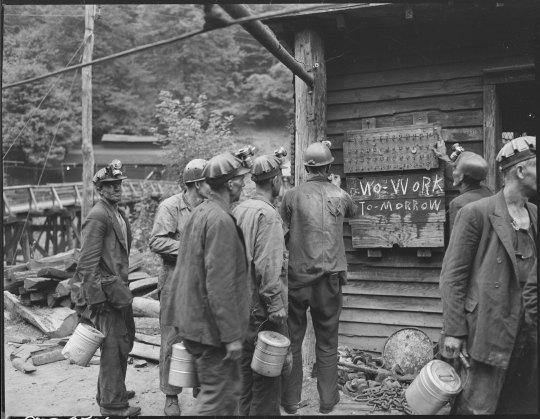#coalmining
Explore tagged Tumblr posts
Text
Power and Light Exhibit 💡

Immerse yourself in the Power & Light exhibit, a profound exploration of the coal miner’s life in 1946 America through the compassionate lens of Russell Lee. A master of documentary photography, Lee was tasked with an extraordinary project following labor strikes—a nationwide survey capturing the essence of remote coal communities. His photos, over 200 of which are featured in our #ArchivesPowerAndLight exhibit, shed light on the rich tapestry of everyday moments against the backdrop of a pivotal time in labor history.

Beyond documenting the gritty realities of coal mining, Lee's photographs celebrate the strength, resilience, and unity of the families that powered these communities. From pride in their homes to solidarity in the mines, every image narrates a story woven into the broader American saga.

Lee, a notable figure among the greats like Walker Evans and Dorothea Lange, believed in the power of photography to create social change. He carried his camera through 13 states, into the homes and lives of those who toiled beneath the earth, and emerged with more than just images—he captured stories that continue to resonate with us today.

This exhibit invites you to traverse time and experience the power and light within this historical archive. Witness the intimate and candid moments Lee immortalized and see the enduring legacy of his work at the National Archives.
93 notes
·
View notes
Text

A coal mine: miners at work above and below ground. Coloured lithograph.
42 notes
·
View notes
Text

Cerrillos Coal Company began mining in Madrid around 1835. It was Coal Gulch before it was Madrid. They built the entire town, including a 6.5 mile standard gauge railroad spur connecting the community to the main line of the Santa Fe Railroad by 1892. The town produced 250,000 tons of coal a year at its peak, with a population larger than Albuquerque.
#New Mexico#NewMexico#travel#roadtrip#daytrip#history#mining#coalmining#smalltownUSA#offthebeatentrack#weekendgetaway
7 notes
·
View notes
Text

1978 Assam India coal mine.
#photography#black and white#india#portait#portraitphotography#portraitpage#analogphotography#analog#coal#coalmining#coalminer
2 notes
·
View notes
Text
Experience Thrills and Traditions at Bridge Day in New River Gorge
Imagine being in one of the most beautiful places on earth with views so stunning that it causes your soul sing with exhilarating joy. The views are so awe-inspiring that they leave you mesmerized. No words can convey the views found in New River Gorge. Each year the communities share their spirit with those who visit on Bridge Day. This day brings a song to the soul and exhilaration of…
#AdventureAwaits#AppalachianCulture#BanjosAndFiddles#BridgeDay#bridges#BridgeWalk#CelebrateLife#coalmining#CoalMiningHistory#CommunitySpirit#CulinaryDelights#extremesports#FallFestivals#FamilyTraditions#FolkMusic#forestry#german#gorge#HistoricLandmarks#MesmerizingViews#NatureLovers#NewRiverGorge#OutdoorFestivals#ScotsIrishHeritage#WestVirginia#YourJourneyAwaits
0 notes
Text
"right, one more attempt, and then i think we're gonna have to call it the end of the session."
mumbo died on his last attempt. right before grian would have ended the session. right before grian could have saved him.
"but i just don't want to kill jimmy..."
he could have taken the shot then and there. he could have lived.
but the miner didn't want to kill the canary. he wanted the canary to live. and he died for it. because miners aren't meant to go into the coal mines alone.
#wild life smp spoilers#wild life smp#traffic smp spoilers#wlsmp spoilers#traffic life#grumbo#mumbo jumbo#grian minecraft#wild life mumbo#trafficblr#traffic series#traffic smp#life series#//#mumbo literally lived in a cave underneath jimmy's base. he went to the coalmine without the canary. and so he died.#fun fact! did you know miners used to get attached to the canaries in mines?#enough they couldn't bare the thought of them dying? that they tried to save them by putting them in glass boxes?#one of the reasons the practice of using canaries was stopped was because they switched to electronic gas detectors.#reminds me of a certain mustached man associated with electronics!
3K notes
·
View notes
Text

rip mumbolion jumbolion he truly mined that coal 💔
i drew this in mspaint instead of studying for a test <3 baby's first time in uni and im already failing a grade....at least i have my minecraft people to watch
#mumbo jumbo#wild life smp#life series smp#wild life mumbo#mumbo fanart#wild life fanart#mcyt#mcyt fanart#!art#guys im devastated#i watched arcane before this too like this was a cherry on top of the misery cake I got today#mined that coal as in the coalminer. you know. the canary and all
2K notes
·
View notes
Text
Elegance Redefined: Innovative Coal Storage Building Solutions

Discover cutting-edge coal storage building designs. Enhance efficiency, embrace durability. Elevate your storage needs with our Steel Structures.
0 notes
Text
The banners went up today for our new exhibit!
“Power & Light: Russell Lee’s Coal Survey” features more than 200 of Russell Lee’s photographs of coal miners and their families.
The man on the banner is Harry Fain, who was working as a coal loader for Inland Steel Company in Wheelwright, Kentucky, in 1946. He and his family appear in photographs throughout the exhibit.
“Power & Light” is free and opens to the public on March 16 in the Lawrence F. O’Brien Gallery in the National Archives Building in Washington, DC.
Visit museum.archives.gov for details.
79 notes
·
View notes
Photo

A Chinese coal mine collapsed under a 600-foot landslide At least five workers are dead in northern China after a sprawling coal mine collapsed under a landslide on Thursday (Feb. 23). The accident happened in the Inner Mongolia province, the country’s top coal-producing region. Reports from Chinese state media indicate more than 40 workers remain missing.Read more... https://qz.com/china-coal-mine-collapse-mongolia-1850149695
#coal#disaster2caccident#coalinchina#likequiang#innermongolia#energy#luotuoshancoalmineflood#xijinping#coalmining#miningaccident#environment#coal miningregion#fuels#Diego Lasarte#Quartz
0 notes
Text
Lizzie and Scott are both sacrificial lambs, but like.
Lizzie is a sacrificial lamb in the sense of. A wounded animal fighting against its bindings, because it isn't fair for its life to be reduced, time and time again, to what cleansing flames can offer other people.
On the other hand, Scott is a sacrificial lamb in the sense of. An animal who follows you and lays down in your lap as you prepare to slaughter it, because it's accepted that it's only worth is in the gain of other people.
If this makes sense to anyone.
#trafficblr#traffic smp#scott smajor#ldshadowlady#in case anyone is curious;#gem is some kind of large herbivore who could gore you with its horns in a heartbeat#hunted for sport. taken down only because hunters dont play fair.#and so so angry about it.#pearl is an abused dog who bares its teeth because violence is all its ever known#jimmy..something something canary something something coalmine..y'know..#it's a traffic jam
403 notes
·
View notes
Text
Coal and Energy Security

India plans to reduce emission intensity of GDP by 45% and aims at generating 500 GW of Renewable Energy from installed capacity by 2030. But India’s energy security has to be met from external sources as more than 85% of petroleum requirements are still imported. Coal, by installed capacity, till date generates 50% of the electricity in India. And 10% of India’s coal is imported. Along with meeting the climate change goals of the future, we may have to generate electricity from coal for the next 2 decades unless there is a new discovery of energy sources or some innovative development in the energy sector in India. The continual integration of renewable energy plants poses grid challenges and hence we have to rely on conventional sources to meet the energy deficits created by intermittent generation . Though we have provided must run status to renewable energy based generations, we should consider life cycle emission of these power plants before planning the phasing out of coal-based generation. Moreover to take the share of renewables from 42%+ to 70%+ would take time. However a switch from coal to natural gas reduces emission intensity by half while keeping the energy security intact. And this may help our future planning.
#IndianChamberofCommerceBlogs#mining#coal#miningtechnology#CoalMine#coalmining#mine#coalminer#charcoal#heavyequipment#industry#renewableenergy#solarpowered#renewables#sustainability#greenenergy#cleanenergy
1 note
·
View note
Text
other artists have made a point of being like "stop saying you hate the pairing but like the art. it's annoying and still insulting" which is fair, but honestly every single time that's happened to me that person eventually came back to say they like them unironically now so. it doesn't even annoy me anymore, lol. oh, so you normally hate this ship? that's nice do tell me more. ignore the crosshair btw
975 notes
·
View notes
Text
if i had a nickel for everytime mumbo accidentally killed himself right in front of grian, who couldn't save him but was forced to watch helplessly anyway, i'd have at least three. which isn't a lot but why does it KEEP HAPPENING
#wild life smp spoilers#traffic life spoilers#wlsmp spoilers#wlsmp#trafficblr#traffic life#traffic life smp#mumbo jumbo#grian#grumbo#//#this is why miners shouldnt go into coalmines without canaries!#CAN'T WAIT TO SEE THIS FROM MUMBO OR GRIAN'S POV.#EVERYBODY SEEING MUMBO DIE AND GOING “oh no... look at grian......”#GRIAN BUILDING HIM A GRAVE.. ATTACKING JIMMY FOR DISRESPECTING IT... AUGH.
269 notes
·
View notes
Text

He’s not getting out
(Batik shadow blue 46)
198 notes
·
View notes
Text

far travelled messenger
are you not curious to what you carry?
like clipping a canary's feathers,
low down do these random gods fall
#gamble the queue#art#my art#digital art#artists on tumblr#drawing#fan art#fanart#rain world#rain world spearmaster#rw spearmaster#rw downpour#rain world downpour#the first letter of every line in that poem spells out fall by the way :DD i like poetry lots#canary was originally passerine but i changed it cause canary in the coalmine. something something he was doomed the moment she fell
443 notes
·
View notes